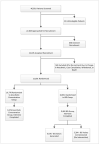Prevention of intraoperative awareness with explicit recall in an unselected surgical population: a randomized comparative effectiveness trial
- PMID: 22990178
- PMCID: PMC3447261
- DOI: 10.1097/ALN.0b013e31826904a6
Prevention of intraoperative awareness with explicit recall in an unselected surgical population: a randomized comparative effectiveness trial
Abstract
Background: Intraoperative awareness with explicit recall occurs in approximately 0.15% of all surgical cases. Efficacy trials based on the Bispectral Index® (BIS) monitor (Covidien, Boulder, CO) and anesthetic concentrations have focused on high-risk patients, but there are no effectiveness data applicable to an unselected surgical population.
Methods: We conducted a randomized controlled trial of unselected surgical patients at three hospitals of a tertiary academic medical center. Surgical cases were randomized to alerting algorithms based on either BIS values or anesthetic concentrations. The primary outcome was the incidence of definite intraoperative awareness; prespecified secondary outcomes included postanesthetic recovery variables.
Results: The study was terminated because of futility. At interim analysis the incidence of definite awareness was 0.12% (11/9,376) (95% CI: 0.07-0.21%) in the anesthetic concentration group and 0.08% (8/9,460) (95% CI: 0.04-0.16%) in the BIS group (P = 0.48). There was no significant difference between the two groups in terms of meeting criteria for recovery room discharge or incidence of nausea and vomiting. By post hoc secondary analysis, the BIS protocol was associated with a 4.7-fold reduction in definite or possible awareness events compared with a cohort receiving no intervention (P = 0.001; 95% CI: 1.7-13.1).
Conclusion: This negative trial could not detect a difference in the incidence of definite awareness or recovery variables between monitoring protocols based on either BIS values or anesthetic concentration. By post hoc analysis, a protocol based on BIS monitoring reduced the incidence of definite or possible intraoperative awareness compared with routine care.
Figures



Comment in
-
Bispectral index versus minimum alveolar concentration for prevention of intraoperative awareness: does a practical controlled trial provide CERtainty?Anesthesiology. 2012 Oct;117(4):693-5. doi: 10.1097/ALN.0b013e3182690586. Anesthesiology. 2012. PMID: 22990175 No abstract available.
-
Why does bispectral index monitoring not perform better?Anesthesiology. 2013 May;118(5):1233-4. doi: 10.1097/ALN.0b013e318289b936. Anesthesiology. 2013. PMID: 23612134 No abstract available.
-
To BIS or not to BIS.Anesthesiology. 2013 May;118(5):1234. doi: 10.1097/ALN.0b013e318289b948. Anesthesiology. 2013. PMID: 23612135 No abstract available.
-
In reply.Anesthesiology. 2013 May;118(5):1235-7. doi: 10.1097/ALN.0b013e318289e1e6. Anesthesiology. 2013. PMID: 23612137 No abstract available.
-
[Hot topics in neuroanesthesia : the five most important publications from the previous year].Anaesthesist. 2013 Jul;62(7):562-7. doi: 10.1007/s00101-013-2194-6. Anaesthesist. 2013. PMID: 23812273 German. No abstract available.
References
-
- Leslie K, Chan MTV, Myles PS, Forbes A, McCulloch TJ. Posttraumatic stress disorder in aware patients from the B-Aware trial. Anesth Analg. 2010;110:823–8. - PubMed
-
- Sebel PS, Bowdle TA, Ghoneim MM, Rampil IJ, Padilla RE, Gan TJ, Domino KB. The incidence of awareness during anesthesia: A multicenter United States study. Anesth Analg. 2004;99:833–9. - PubMed
-
- Sandin RH, Enlund G, Samuelsson P, Lennmarken C. Awareness during anaesthesia: A prospective case study. Lancet. 2000;355:707–11. - PubMed
-
- Joint Commission on Accreditation of Healthcare Organizations. Preventing and managing the impact of anesthesia awareness. Jt Comm Perspect. 2004;24:10–1. - PubMed
-
- Myles PS, Leslie K, McNeil J, Forbes A, Chan MT. Bispectral index monitoring to prevent awareness during anaesthesia: The B-Aware randomised controlled trial. Lancet. 2004;363:1757–63. - PubMed
Publication types
MeSH terms
Substances
Grants and funding
LinkOut - more resources
Full Text Sources
Other Literature Sources
Medical
Miscellaneous

